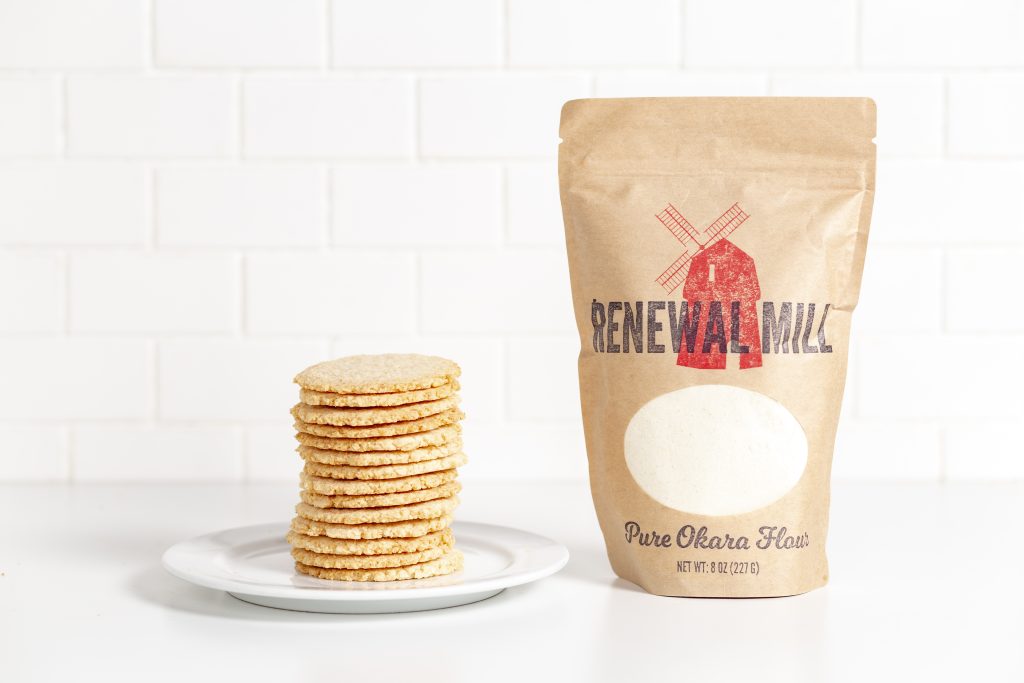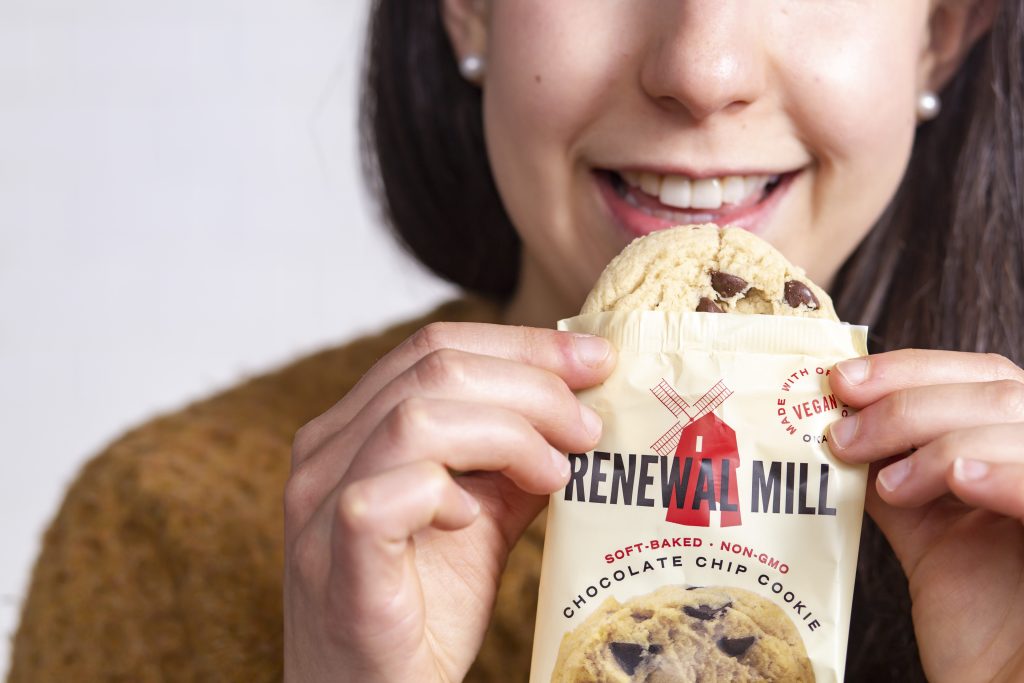Renewal Mill, a Bay Area food ingredients company that upcycles the byproduct leftover from soy milk production, is at the forefront of the food waste movement. Its current focus is okara, the wet pulp-like substance that’s left behind after the soy milk manufacture process. Renewal Mill transforms okara into a nutrient-rich flour that can be used in everyday kitchens to bake soft, vegan chocolate chip cookies, gluten-free pancakes, high-fiber muffins and much more. Caroline Cotto, Renewal Mill’s chief operating officer, first discovered the company during Techstars Farm-to-Fork Accelerator program. With her background studying human science with a focus on nutrition at Georgetown University, Cotto said she was drawn to Renewal Mill’s vision: to close the food waste gap at the manufacturer level. She then met CEO Claire Schlemme and together they’ve secured funding in January to continue the company’s mission of introducing consumers to the endless possibilities of upcycled foods.
The VINE spoke to Cotto to learn more about okara flour and its nutritional benefits, what’s in store for Renewal Mill in the years to come and how people are responding to the upcycled food movement.
What intrigued you about Renewal Mill’s vision?
I was really excited about food-waste reduction and Claire’s unique approach to solving food waste at the manufacturing level. Because I come from a nutrition background, I was also really excited about the product. The company was founded with this dual-mission of reducing food waste and keeping valuable nutrition in the supply chain and making nutrition affordable, which I found really attractive as well.
How has new seed investments helped further propel Renewal Mill’s mission?
Prior to the seed investment, we had been operating on pilot equipment so we’ve used that money for capital expenses to be able to scale up to full production at our first partner facility and get full-scale drying equipment to be able to do more output and processing of the byproducts. We’ve also been able to expand our team, which has been really helpful for scaling the business as well.
Do you have a place of business where you’re drying and milling your product now?
Renewal Mill has a unique model in that we use a co-location model. So we put our technology into the facilities of our manufacturing partners. We’ll never have our own manufacturing facility, but we do now have our own office space.

A recent study by ReFed showed in 2011 about 11 upcycled food companies existed. In 2017, there were 64 in operation and counting. Do you think this demonstrates a growing consumer interest in upcycled products?
Over the last two years, the consumer has finally become aware of the food waste issue. People know that 30 to 40 % of food we produce is never eaten, depending on whether you’re looking at the global level or the U.S. level. Now, they want to know how to help and it’s fueling the growth of upcycled products. Mattson, which is a huge food product development and research company, released a study this year that said 39% of consumers actively want to purchase food with more upcycled ingredients and that is expected to grow to 57% next year.
Where do companies showcase their innovations to test the waters in the upcycled food world?
Upcycled products have headlined some of the biggest food shows this year like the Summer Fancy Food show and the Institute of Food Technology food expo. Upcycled ingredients are really at the forefront of what’s hot and what’s new at those conferences. I think people are really excited about the movement. They want to know how they can help and there’s this added urgency around climate change and people know food waste is helping fuel climate change. Upcycled ingredients are a way to help tackle that.
What has Renewal Mill done to shift consumers view of upcycled products? Are some people intimidated about eating “byproducts?”
It definitely requires consumer education, especially early on in the food-waste movement. People were like, “I don’t want to eat trash,” and that’s definitely not what we’re trying to do. (Laughs.) We’re just basically trying to say that we’re sourcing currently unharvested ingredient streams and keeping them in this circular economy. We’re trying to educate people about these premium ingredients that have been arbitrarily labeled as “waste” because people haven’t been creative enough or found a way to use it. But it’s packed full of nutrition. It’s super clean label. It fits a lot of the consumer trends and dietary trends with really low net carbs, gluten-free, high-fiber and high-protein. So we’re definitely trying to put it in that premium light and show people that we can create circularity around supply chains in a way that’s better for you and better for the environment.
Where does Renewal Mill source its soybeans from or what are the different manufacturers it partners with?
Our first partner is Hodo Foods, they’re the third-largest tofu company in the U.S. and the largest artisanal tofu company. They supply tofu to Chipotle nationwide and they’re also in every Whole Foods and Target. They source really premium, organic, non-GMO soybeans, and as a result, our okara is also organic and non-GMO. They’re our first partner, so we work really closely with them, but we’re also going to be bringing on two additional partners this year who are also organic tofu producers in the Bay Area.
Does Renewal Mill currently source olives, potatoes, almonds and grapes for additional byproducts or is it solely focused on soybeans at the moment?
Right now, we’re focused on okara. As you can imagine, scaling a new ingredient takes a lot more time than you would anticipate so that’s our first ingredient. But we’re hoping in 2020 to bring on a second ingredient, which will also be a byproduct of plant-based milk production and we’re looking at a variety of options such as almonds and oats.
Do you know the current volume that Renewal Mill is converting to flour?
Our partner, Hodo, produces 40 tons of wet okara per week. At full-scale production, we’re the complete off-take solution for their byproduct.
How often are you turning the wet okara, milling and drying it into okara flour?
We’re still waiting on the instillation of our full equipment, so we’re scaling up to that. But, we will be taking all of the volume.
Do you have an estimate of how much okara would be diverted from landfills by taking on that volume?
Okara itself has like 40% of the carbon footprint of wheat flour and that comes from preventing decomposition in a landfill and that’s the same for other substitute crops like wheat. We work with multiple partners and each partner is doing something slightly different with their okara right now. Hodo actually has some cattle farmers come pick it up, but it’s not a reliable off-take solution because if the price of a premium cattle feed goes down, then they won’t come get it and then Hodo has to pay to have it carted away to landfills. Some of the other partners that we’re working with, they don’t have farmers in their area that are willing to come get it, so it goes directly to landfills. When we’re at full capacity, we’ll be taking all of it from Hodo, and ideally, from our other partners as well.
Can you tell me a little bit about the process from soybean to okara flour?
Sure, soybeans are soaked, then boiled and blended and the liquid portion is siphoned off as soy milk and what’s left is this soybean pulp and that’s called okara. So it comes out of the soy milk machine with soy milk on one side, okara on the other. The okara is directly funneled into our dehydration equipment and then it comes off of the dehydrator as a flake, which we then mill into the final form of the ingredient, which is this high-fiber, gluten-free flour.
You mention those key dietary words that consumers look for: “low-carb” and “gluten-free.” What are some additional nutritional benefits of okara flour?
Americans are really deficient in fiber. There’s been a lot of buzz around protein, but actually like 97% of Americans are deficient in fiber—not protein. Okara has a lot of insoluble fiber in it, which is really great for nutrition. There have been a lot of research studies on okara. It can help with heart health, it can help with weight maintenance, it can help with muscle recovery and it’s also prebiotic fiber so it’s good for your gut. As I mentioned, it’s gluten-free, it’s grain-free and it’s coming from a whole-soy product so it’s a whole protein. Basically, fiber is its main play so adding just a little bit of okara can get you up to an excellent source of fiber in whatever products you’re making for the day. It’s also quite high in calcium compared to a lot of other flours and upcycled fours on the market.
Does it pack a distinct flavor or is it neutral so it makes it more versatile for cooking or baking?
Yeah, exactly. Because a lot of the flavor notes that make soy taste like soy are water soluble, they move into the soy milk and what’s left in the okara is very neutral in flavor and it’s very neutral in color, which makes it easy to integrate into other products and to put additional flavors on top of. It’s kind of unique in the upcycled space because a lot of the other products have a very distinct color and distinct flavor.

Do you use okara flour at home?
Yeah, I do. It’s a really great way to make a flour-based product that you want to make low-carb. I use it routinely for muffins and for pancakes. But it’s really versatile. You can make everything from crackers to baked goods to extruded puff snacks to vegan meat products. It really is category agnostic.
I’m wondering what kids think about okara flour or if they would even tell the difference?
So Claire, our co-founder and CEO, has a 6-month-old baby and she’s just starting to introduce him to foods, but looking at introducing okara because there’s a lot of research on early allergy introduction for kids. We also have someone who has helped us with product development named Hetal Vasavada, she was a MasterChef contestant, and she used it to make vegan meat products that she fed to her 2-year-old and her 2-year-old loved them. She was really impressed with how she was able to create a really filling vegan meat product that her kid loved.
Where can people find Renewal Mill’s okara flour besides its website?
We’re mostly selling large volumes of flour to consumer-packaged goods food companies that want to use it in their products. We do sell it through our website and through Imperfect Produce through their online add-on marketplace. We’re also looking to move into a few retail locations in the Bay like Berkeley Bowl and Bi-Rite. Mostly, we sell cookies in retail so we use the okara flour to make a vegan, soft-baked chocolate chip cookie, which we sell in the Bay Area and are looking to expand.
Do you think the next generation of ingredients will move more toward the direction of upcycled products?
Yeah. I think if you look at the climate change studies that have been coming from the United Nations, we have to be more efficient in utilizing the food that we grow in order to feed the population because it’s going to outpace the amount of food we’re able to produce; and if we don’t take better care of our land, we’re not going to be able to produce enough food. So I think utilizing previously untapped sources and supply chains in our food system is going to be increasingly important in reducing our waste because we only have 10 years to really make an impact in reducing this food-waste issues and climate change.
About the author: Steph Rodriguez is an award-winning journalist and dining editor at the Sacramento News & Review who enjoys crafting stories that mirror the vast and diverse culture of the region. She’s also a two-time scholarship recipient with the Sacramento Press Club and keeps a close eye on the latest in food and agriculture news throughout the Farm-to-Fork Capital. Follow her on Twitter: @Wordstospill.

